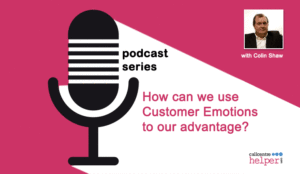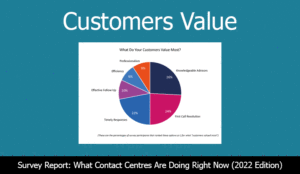Here are seven steps to evoke positive emotions from your customers that will benefit your business.
1. Embrace the Fact People Buy Emotionally and Justify With Logic
People make their buying decisions based on their emotional instincts, but later justify that decision to themselves, their friends and/or their family with practical reasons.
For example, Colin Shaw, Founder & CEO of Beyond Philosophy, says: “I was in India for a construction equipment company and some customers came to pick up a product, but – after one glance – they walked away.”
“When I asked ‘what’s happening?’, they said that the serial number was not a lucky number so they didn’t want that piece of equipment. This is because, in India, the number eight is a lucky number and the number four is unlucky.”
Everybody likes to think that they have been logical with their decision making, but we buy emotionally, through the subconscious part of our brains.
The lesson here is that everybody likes to think that they have been logical with their decision making, but we buy emotionally, through the subconscious part of our brains.
With this in mind, organisations shouldn’t just be offering a service that meets the customer’s functional needs, it should be designed to meet the customer’s emotional needs as well.
2. Realise That Sometimes Customer Don’t Know What They Really Want
All to often customers will tell you one thing and then do another. If the customer tells you that the service was good, it doesn’t mean that it was.
This is according to Colin, who puts forward the following model, which helps you to prioritise different aspects of your service against their value to your business.
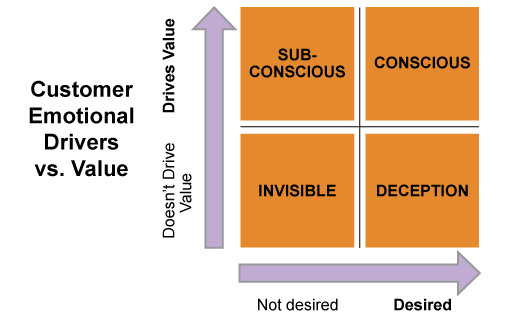
Describing each of the four quadrants that are in the chart, Colin says:
Subconscious – These are the things that customers don’t say that they want but that actually drive value. This is where emotions lie, within the values that customers don’t articulate.
Conscious – These are the things that customers say they want and, if you give it to them, customer satisfaction increases. Simple.
Deception – These are the things that customers say that they want but that don’t necessarily drive value. For instance, Disney know that when they ask customers what they’d like to eat at a theme park, customers say that they’d like to have a salad option – but Disney know that nobody eats salad at a theme park.
Invisible – These are the things that aren’t desired and do not drive value.
So, the goal is to focus more on the subconscious elements of your customer experiences and focus less on the key deception elements.
To do this, we need to define the subconscious emotions that drive and destroy value…
3. Define the Emotions That Drive Value for You
When we talk about value, we talk in terms of increased spend, profitability, Net Promoter Score and so on. So, we want to find out how certain emotions impact each of these important metrics.
According to our poll below, 21% of organisations are now doing this, which is great as it involves a great deal of research with your customers.
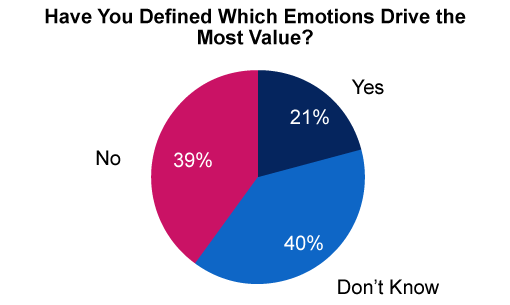
The data for this chart was sourced from our webinar: 7 Ways to Emotionally Engage With Your Customers
This research revolves around finding your company’s “Emotional Signature”, with different organisations having different signatures.

Colin Shaw
When applying the Emotional Signature, Colin says: “Up to 40 stimuli attributes, 20 emotions and eight value indicators are used to conduct complex modelling that in the end will show us the relationship between the stimuli, emotions and business value.”
A link to Colin’s full report, in which he goes through how to conduct the necessary research, is included in the yellow box below, which is research that companies like Maersk – the container ship company – have now conducted.
Maersk identified that “trust”, “cared for” and “pleased” were the three most key emotions in their Emotional Signature, from which they were able to make a series of customer commitments for each.
For example, to evoke the emotion of “trust” Maersk came up with the following promises:
Making the customer feel trust means:
- Setting proper expectations
- Always responding within the committed timescales
- Staying up to date on issues that impact the customer
- Owning up to mistakes
- Taking responsibility and ownership of solving problems
- Operating with high safety and environment standards
- Being honest and upright
Making the customer feel trust doesn’t mean:
- Blaming other Maersk departments or systems
- Telling customers to call someone else
- Hiding mistakes or issues
- Bypassing or being ignorant of legal issues
- Acting as a poor corporate citizen
By applying these principles at every touchpoint of their customer journey, Maersk increased NPS by 40 points and realised a 10% rise in shipping volume over a 30-month period.
So, finding out the best emotions to evoke for your organisation and making customer commitments has great value, but you can go even further…
For a full overview of how to conduct “Emotional Signature” research, read Colin’s report: Emotional Signature (ES) – The Role of Emotions in Customer Experience
4. Use Emotions to Structure the Customer Experience
A few years ago, Professor Daniel Kahneman won the Nobel prize for behavioural economics after theorising that we have our “experiencing self” and our “remembering self”.
Our “experiencing self” embodies the emotions that we feel during the experience and our “remembering self” embodies the emotions that we feel when we look back upon the experience in the future.
So, when people ask you what your experience was like, what you tell them is clearly a memory.
Discussing this research, Colin says: “We don’t choose between experiences; we choose between the memories of an experience. This is important because a memory is what customer loyalty is. You can’t be loyal to somebody unless you have a memory.”
So, when we create a customer experience, we need to ask ourselves; how are memories formed?
To answer this question, we need to go back to Kahneman’s research, which dictates that in any experience, people remember the peak memory and the end memory that they felt. This is otherwise known as the peak-end rule.
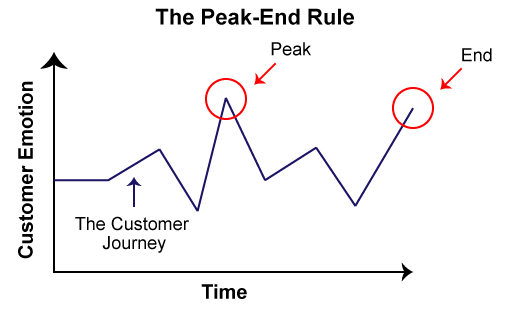
So, organisations need to ask themselves two questions; where is the (either high or low) peak in their journey? And, what is the end emotion that you’re trying to evoke in your customers?
5. Design an Emotionally Engaging Customer Experience
Now we know which emotions to create, based on value, and where we want to specially evoke them, now we’ve got to design the customer experience.
To emotionally engage with customers, you need to plan it. So, this is where journey mapping comes in, starting off with a framework of every “step” or “touchpoint” the customer takes within their experience with your brand.
Then, Colin suggests that you ask yourself: “In which step is that peak emotion? And, if you’re trying to evoke an emotion like ‘trust’, how are you going to evoke it? This is both at the peak of the experience and at the end.”
Think of this as a story-telling exercise, with emotional peaks and functional requirements. Try to add value in the moments that matter.
You can almost think of this as a story-telling exercise, with emotional peaks and functional requirements. Try to add value in the moments that matter.
Just make sure that you test your experience through mystery shopping and monitoring feedback to ensure that you are evoking the right emotions from customers.
6. Train Your People to Evoke These Emotions
Once you have designed the journey to evoke the right emotions, you have to train advisors and other customer-facing service staff to serve customers to evoke the same emotions from customers.
Colin says: “When I get home at night, within a one-word response from my wife, I know how she’s feeling, what I shouldn’t do to make her feel worse and what I should do to make her feel better. The same applies with your customers.”
“An advisor’s job should be to move the customer away from what they are feeling when they contact you and towards a desired emotion.”
You need to teach advisors to look out for emotional signals, whether they are looking to move away from negativity or towards positivity.
So, in training, you need to teach advisors to look out for emotional signals, whether they are looking to move away from negativity or towards positivity.
Then, once you help build emotional intelligence, it is good to coach techniques that will help the customer to “form” their desired emotion – sharing recordings with the group of how other advisors have done so in the past.
With this in mind, it’s also important that you maintain the advisor’s motivation to “pull” to customer towards the desired emotion. This comes through having a good culture of recognition, support and fun.
For more about culture, read our article: What Is the Best Model for Contact Centre Culture?
7. Measure the Emotions That Drive Value for Your Specific Organisation
Through activities like mystery shopping, customer feedback and indirect financial measures, such as increased spend, you can track whether your strategy to evoke the right emotions is working.
However, a much better indicator is to measure emotions directly and you can do that by implementing an analytics system.
Take the diagram below, it is an example of how interaction analytics can scan text (or speech-to-text transcripts) and pick out useful insights. One insight is finding words that insinuate an emotion.
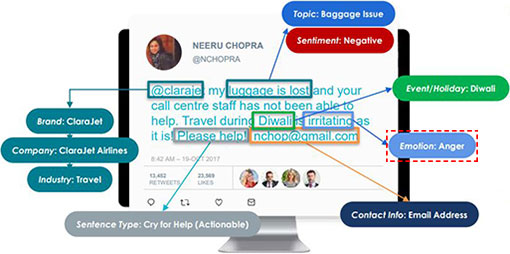
In this example, the speech analytics systems detects the word “irritating”, highlighting it to be a word that indicates anger.
So, a contact centre can list a number of words that indicate an emotion and group them into broader emotions. Using the image above as an example, the word “irritating” would be filed under the broader emotion of “anger”.

Fabrice Martin
Fabrice Martin, Chief Product Officer at Clarabridge, adds: “Every interaction that you have in your contact centre can automatically go through this process, to tease out all the emotions that are being expressed by the customer (as well as the advisor) both directly and indirectly.”
“You can then aggregate them to assess how good a job you’re doing in evoking your preferred emotions and you can track them as the experience unfolds.”
You can also measure customer emotion through surveys to track the entire customer journey, to create a Net Emotion Value (NEV), but it’s difficult to do this well without risking survey fatigue.
For more on measuring emotion, read our article: How to Measure Customer Emotion
In Summary
A good customer experience meets both the customer’s emotional and functional needs, which we appreciate once we think about how we buy through emotion and justify with logic.
So, we need to think about what our customers’ emotional drivers are, both conscious and subconscious. Then we want to quantify those against value.
Once we know the emotions that are really valuable for us to evoke, we make customer promises and commitments and make sure we are hitting those at every stage of the customer journey.
But we want don’t just want a consistently good experience, we want a couple of great peaks that customers will remember. One in the middle of the journey and one at the end. These peaks will be designed to hit a valuable emotion for your business.
Finally, teach advisors to also evoke the most valuable emotions and measure emotions throughout the customer experience, either through a NEV score or using an analytics system.
Author: Robyn Coppell
Published On: 5th Jun 2019 - Last modified: 23rd Sep 2022
Read more about - Customer Service Strategy, Clarabridge, Customer Psychology, CX, Editor's Picks, Emotion







